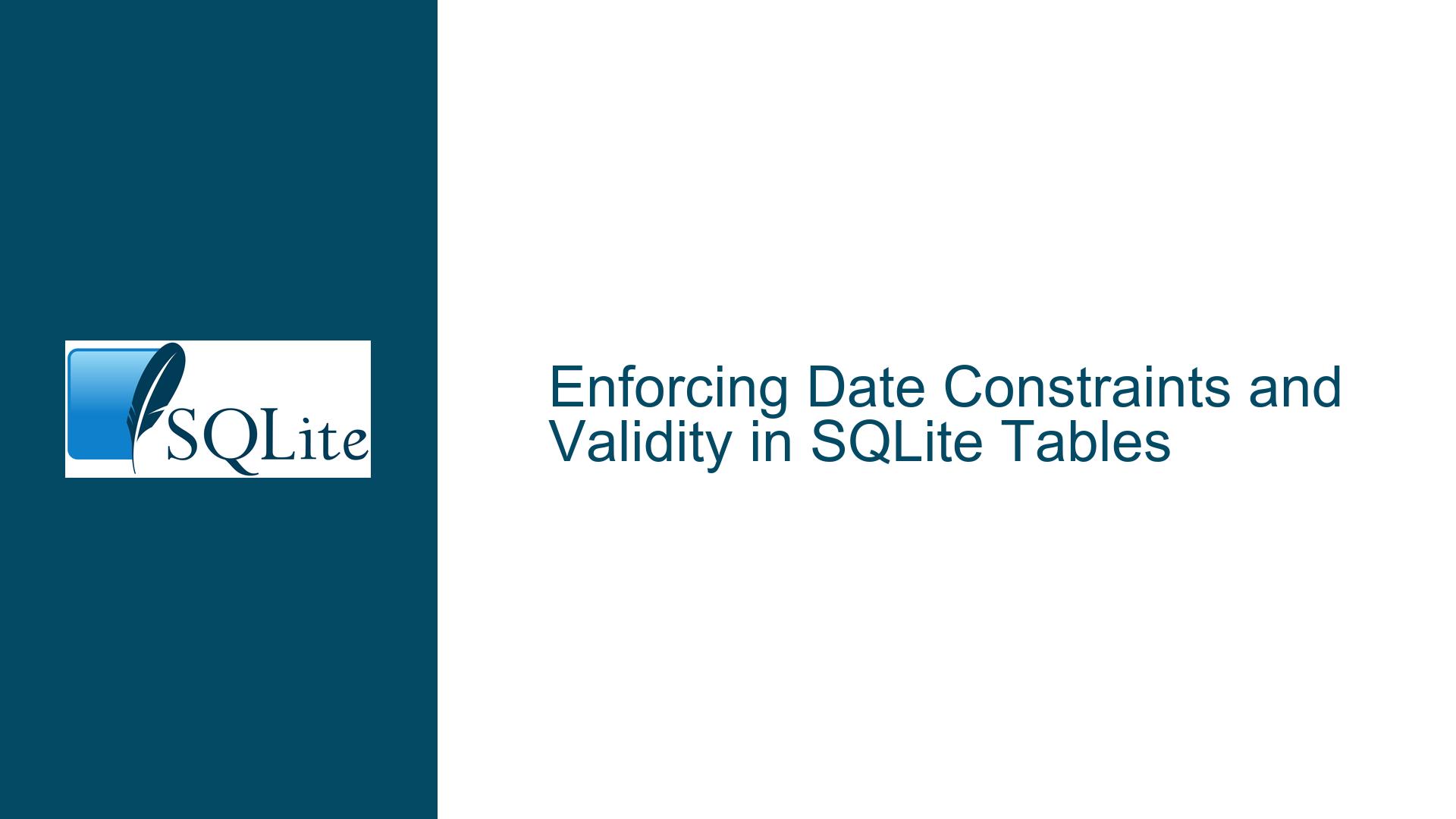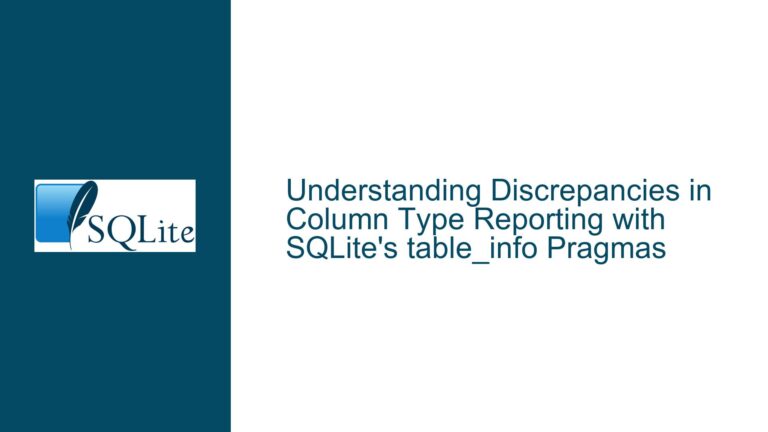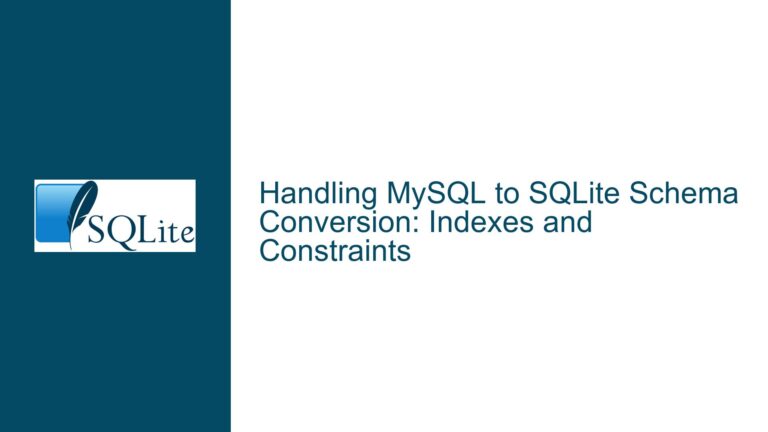Enforcing Date Constraints and Validity in SQLite Tables
Ensuring Valid Dates and Correct Date Relationships in SQLite
When designing a database schema in SQLite, ensuring data integrity is paramount. One common requirement is to enforce that certain columns contain valid dates and that these dates adhere to specific relationships. For instance, in a table tracking issues or tasks, you might have a created column representing the date an issue was created and a resolved column representing the date it was resolved. The created column should always contain a valid date, while the resolved column should either be NULL (indicating the issue is unresolved) or contain a valid date that is later than the created date.
The challenge lies in implementing these constraints effectively. SQLite provides several mechanisms to enforce data integrity, including CHECK constraints, NOT NULL constraints, and default values. However, the nuances of these mechanisms can sometimes lead to unexpected behavior if not carefully considered. This post will explore the intricacies of enforcing date constraints in SQLite, focusing on ensuring that dates are valid and that the relationship between created and resolved dates is maintained.
The Pitfalls of Date Validation and Comparison in SQLite
One of the primary issues when working with dates in SQLite is ensuring that the values stored in date columns are indeed valid dates. SQLite does not have a native date type; instead, dates are typically stored as text in the ISO8601 format (YYYY-MM-DD). This flexibility allows for a wide range of date representations but also opens the door to potential data integrity issues if invalid dates are inserted.
The problem is compounded when you need to enforce relationships between dates. For example, if you have a created date and a resolved date, you might want to ensure that the resolved date is always greater than the created date. However, this requires not only that both dates are valid but also that the comparison between them is meaningful.
A common approach to validating dates is to use the date() function, which attempts to parse a date string and return it in the ISO8601 format. If the input string is not a valid date, the function returns NULL. This behavior can be leveraged in a CHECK constraint to ensure that only valid dates are stored in a column. However, as we will see, this approach has its limitations and can lead to subtle bugs if not implemented correctly.
Another issue arises when dealing with NULL values. In SQLite, NULL represents the absence of a value, and comparisons involving NULL can behave unexpectedly. For example, the expression NULL > '2020-01-01' evaluates to NULL, not False. This behavior can affect the enforcement of constraints, particularly when dealing with optional date columns like resolved.
Implementing Robust Date Constraints and Relationships
To address these issues, we need to implement a set of constraints that ensure both the validity of dates and the correctness of their relationships. Let’s start by examining the created column. This column should always contain a valid date, and it should default to the current date if no value is provided. We can achieve this using a DEFAULT clause and a CHECK constraint:
CREATE TABLE issues (
created TEXT DEFAULT CURRENT_DATE NOT NULL
CHECK (created IS date(created, '+0 days')),
resolved TEXT
);
In this schema, the created column is defined as TEXT with a default value of CURRENT_DATE, which automatically inserts the current date in ISO8601 format. The NOT NULL constraint ensures that the column cannot contain NULL values. The CHECK constraint uses the date() function to validate that the value in the created column is a valid date. The expression created IS date(created, '+0 days') ensures that the value in created is a valid date by comparing it to the result of the date() function. If the value is not a valid date, the date() function returns NULL, and the IS comparison fails, triggering the CHECK constraint.
Next, we need to enforce the constraints on the resolved column. This column should either be NULL or contain a valid date that is greater than the created date. We can achieve this with another CHECK constraint:
CREATE TABLE issues (
created TEXT DEFAULT CURRENT_DATE NOT NULL
CHECK (created IS date(created, '+0 days')),
resolved TEXT
CHECK (resolved IS NULL OR (resolved IS date(resolved, '+0 days') AND resolved > created)
);
In this schema, the resolved column is defined as TEXT with no default value, allowing it to be NULL. The CHECK constraint on the resolved column ensures that if the column is not NULL, it contains a valid date and that this date is greater than the created date. The expression resolved IS NULL OR (resolved IS date(resolved, '+0 days') AND resolved > created) ensures that the resolved column either contains a valid date greater than created or is NULL.
However, there is a subtle issue with this approach. The CHECK constraint on the resolved column uses the > operator to compare the resolved date with the created date. In SQLite, the > operator returns NULL if either operand is NULL. This means that if resolved is NULL, the expression resolved > created evaluates to NULL, and the CHECK constraint is not triggered. This behavior is correct in this case because we want to allow NULL values in the resolved column. However, it is important to understand this behavior to avoid potential pitfalls when designing constraints.
To further illustrate the behavior of these constraints, let’s consider some example insertions:
-- Valid insertion: resolved is NULL
INSERT INTO issues (created, resolved) VALUES ('2020-01-01', NULL);
-- Valid insertion: resolved is a valid date greater than created
INSERT INTO issues (created, resolved) VALUES ('2020-01-01', '2020-01-02');
-- Invalid insertion: resolved is not a valid date
INSERT INTO issues (created, resolved) VALUES ('2020-01-01', 'crappola');
-- Error: CHECK constraint failed: resolved
-- Invalid insertion: resolved is a valid date but not greater than created
INSERT INTO issues (created, resolved) VALUES ('2020-01-01', '2019-12-31');
-- Error: CHECK constraint failed: resolved
These examples demonstrate how the constraints enforce the validity of dates and the correctness of their relationships. The first two insertions succeed because they adhere to the constraints, while the last two insertions fail because they violate the constraints.
In conclusion, enforcing date constraints and relationships in SQLite requires a careful understanding of the behavior of CHECK constraints, NULL values, and date functions. By leveraging these features effectively, you can ensure that your database maintains data integrity and adheres to the business rules of your application. The schema and constraints presented here provide a robust foundation for managing dates in SQLite, but it is important to test and validate your constraints thoroughly to ensure they behave as expected in all scenarios.






